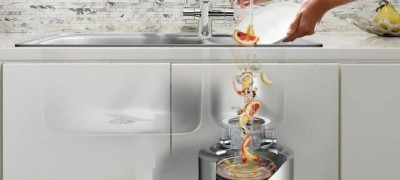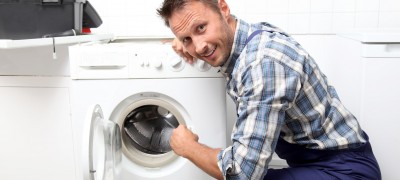Which iron coating is best
The correct choice of iron affects how well it will iron, how long it will serve and perform its functions, and whether it will be convenient to use it. First of all, it is important to pay attention to the sole of the device, which can be made of innovative durable materials and have various shapes. Which iron sole is best?

Why the sole of the iron is so important
The sole is the most important element of the device. The ironing result and the safety of fabrics depend on its quality. The iron should slide smoothly over the surface and smooth out any existing creases.
Nothing newfangled features like remote control or many different modes matter if the sole tends to leak, melt things, or cling to fibers. For this reason, when choosing home appliances, first of all, you need to pay attention to the material of manufacture, shape and other characteristic features of the sole.

What are the forms of soles
The shape of the soles are:
- with a sharp nose;
- rounded (with a blunt nose).
With the sole of what shape is it better to choose an iron? In the first case, the iron is ideal for ironing shirts, wardrobe items with many small parts and accessories, children's clothing. If the house is dominated by large things, bed linen, towels, it is more convenient to use devices with a large surface and a rounded nose.

The back of all models should be oval. Otherwise, the fabrics will wrinkle during the reverse movements of the iron.

Types of soles
One of the most important factors that influences the choice of technique is the material of the sole part. Currently, there are more than a hundred varieties of platforms of varying degrees of strength, sliding and other features.

Aluminum
Aluminum soles are the most affordable. Other advantages of this type of model:
- light weight;
- rapid heating and cooling.

Minuses:
- the sole is easily scratched, it is unstable to mechanical stress, subsequently the scratches that appear cling to the fibers of the fabric and lead to damage to things;
- in the presence of small scratches, they gradually accumulate carbon deposits and dirt particles;
- over time, the sole begins to slide worse on the material, even with proper use and careful care;
- iron marks in the form of shiny areas may remain on things.
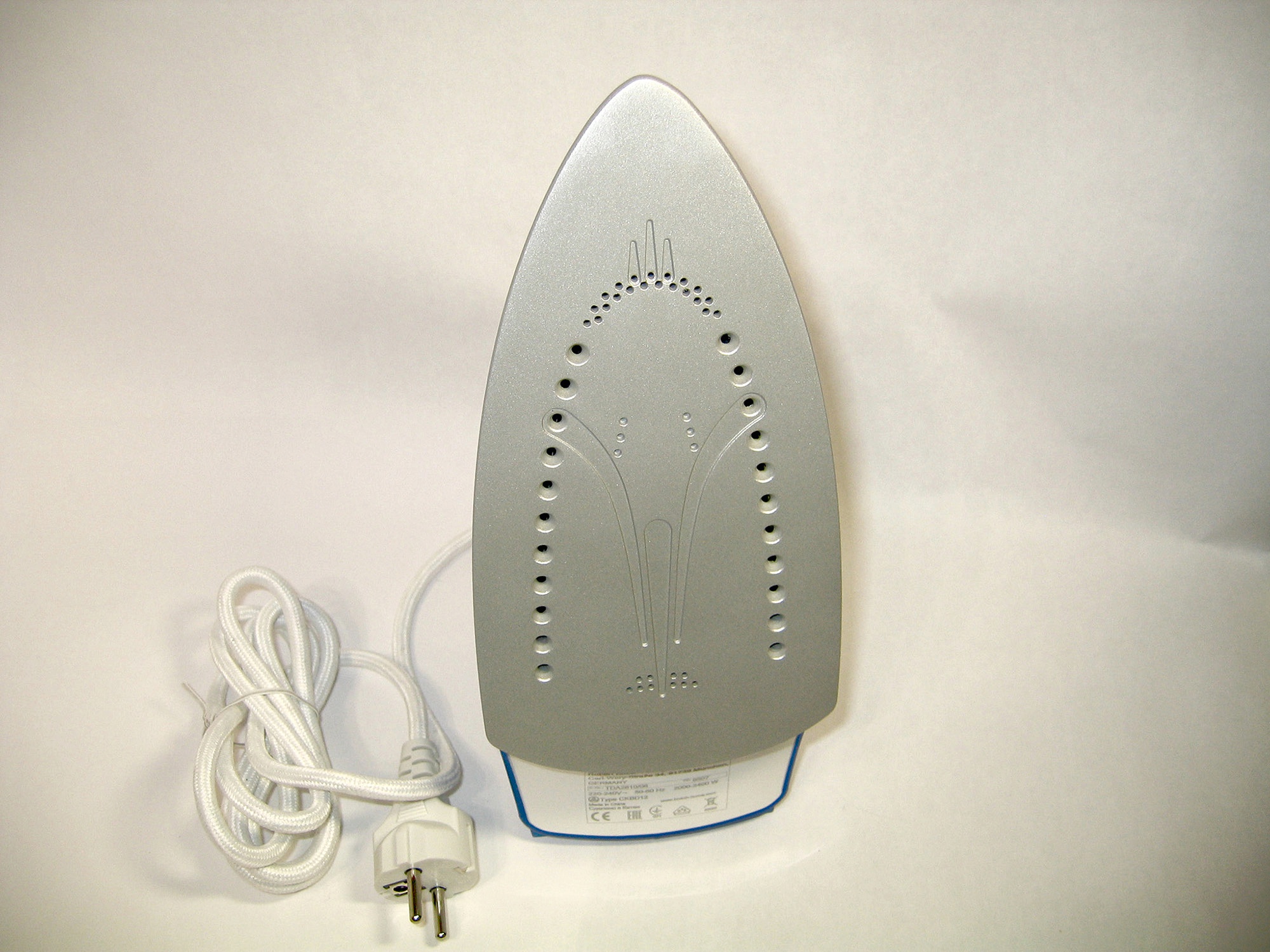
Important! It was aluminum that was the first to replace the first cast-iron devices, which weighed a lot, took an extremely long time to warm up and had an inhomogeneous platform that slid poorly and clung to fabrics.
Anodized
Aluminum is processed in a special way - anodic oxidation. Based on the results of the manipulations, an oxide film is formed, which additionally protects the platform from external influences. The anodized coating has a matte structure, so after ironing there are no marks left on things.

Ceramic
The sole element is made from inorganic compounds and mineral additives and then applied to a steel or aluminum base. The advantages of such a sole:
- better sliding on matter;
- delicate ironing of fabrics;
- ease of use and maintenance;
- uniform heating of the working surface;
- affordable price.

A significant disadvantage of the ceramic sole is its fragility. If at least one chip forms on the surface, the entire spray can peel off at once. Over time, the damaged plantar part becomes covered with numerous cracks, which cannot be eliminated.

Sintered metal
Since ceramic soles are of low durability, many manufacturers add nickel or chrome to the material. In the first case, the surface becomes golden, in the second - bluish. Ceramics are combined with other metals and alloys. The metal-ceramic surface is resistant to external damage and impact, such a sole easily glides over fabrics and smoothes folds of any complexity.
The material is used by leading equipment manufacturers such as Tefal, Braun, Philips, etc. Models based on cermet are more expensive than other types of irons.

Stainless
Stainless steel is considered one of the most reliable materials, many manufacturers use this option when creating durable models, moreover, it has a low cost, which affects the final price of the device. Pluses of stainless steel:
- resistance to mechanical damage;
- anti-corrosion properties;
- long service life;
- excellent sliding on matter;
- uniform heating of the platform;
- low cost;
- ease of care and operation;
- after ironing, no creases remain on the fabrics.

Disadvantages:
- heavy weight;
- long heating of the working surface.
Stainless steel is often supplemented with other metals. For example, chromium is excellent for this, which improves anti-corrosion properties and extends the life of the product.
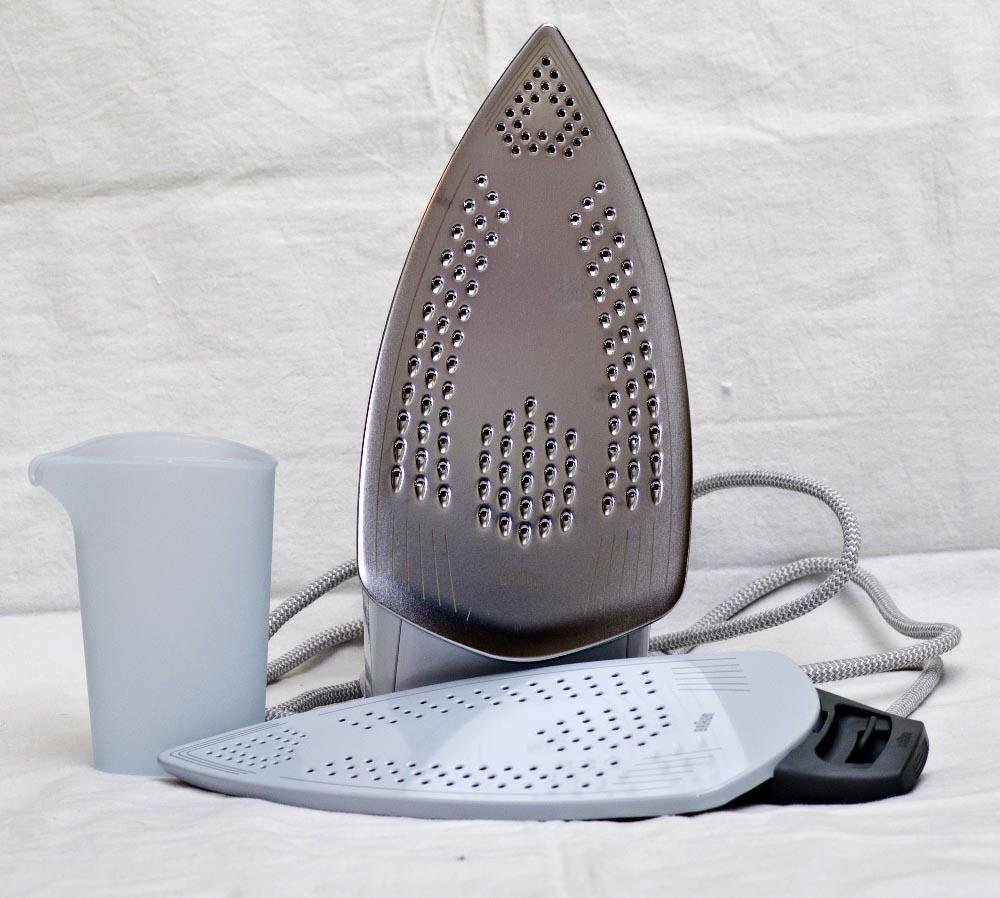
Teflon
This coating has many similarities with aluminum. This is the best option for smoothing the most sensitive and delicate fabrics like silk, synthetics, wool. Teflon advantages:
- fast easy sliding on matter;
- high-quality ironing - elimination of folds of any complexity;
- non-stick properties;
- ease of care.
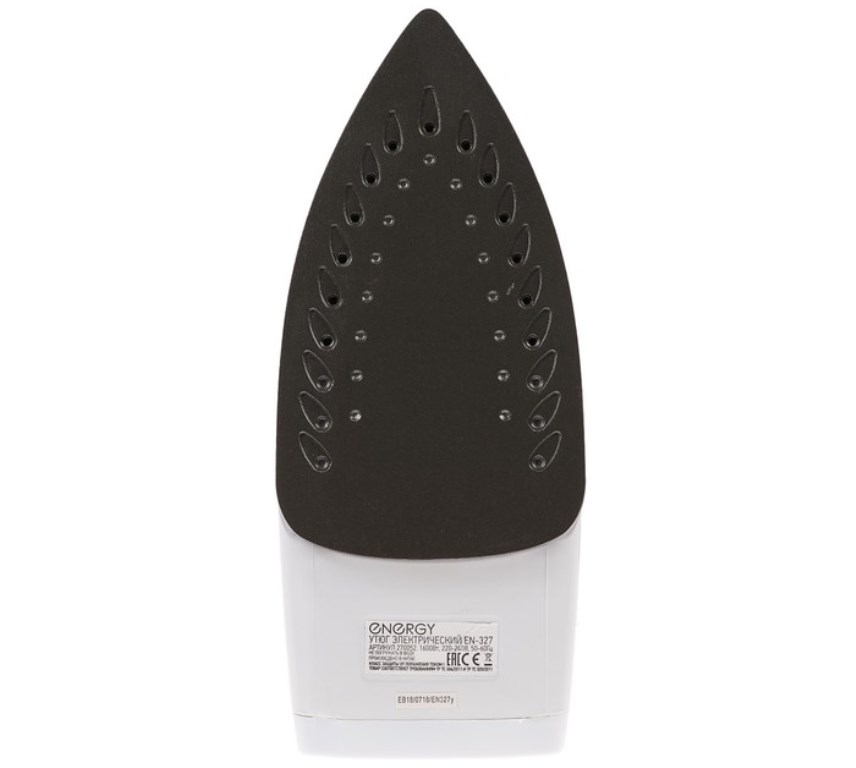
The disadvantages include the susceptibility of the material to mechanical damage. Teflon will not last as long as cermet or stainless steel.
Non-stick
The iron with a non-stick soleplate is able to cope with folds of any complexity and smooth out various types of fabrics, including delicate ones. Using this technique, you can put in order clothes with many decorative elements (rhinestones, buttons, brooches, etc.).
Non-stick coating does not leave shiny streaks on fabric. However, as is the case with Teflon and aluminum, such surfaces are easy to damage, they quickly lose their properties.

Titanium
Titanium plating is applied to stainless steel. This metal has the highest strength, which is its main advantage. Other pluses of a titanium sole:
- long service life;
- non-stick properties;
- good sliding on materials;
- uniform heating.

Minuses:
- long heating;
- heavy weight;
- high price.
Manufacturing technologies
Many well-known manufacturers have their own manufacturing technologies for the sole part of the irons, which they have been successfully using for many years:
- Autoclean Crystal. This is a ceramic sole that is used by Tefal and Bosch. The self-cleaning surface heats up quickly and easily smoothes out creases of any complexity. It is important to remember that this material is very fragile.
- Crystal Ceramic. This is the ceramic sole that Polaris uses in its devices. Pros: easy wrinkle removal, non-stick properties, fast, even heating, high-quality steaming. However, these irons are very fragile.
- T-ionicGlide. The stainless soleplate in Philips irons reaches the highest temperatures and can iron very wrinkled items. The stainless steel is durable, can be cleaned on its own, warms up quickly and does not leave marks on clothes.
- Autoclean Catalys. The palladium sole in Tefal irons has a self-cleaning function, does not leave marks, glides perfectly on the material, but is easily exposed to mechanical stress.
- Airglide Autoclean. Tefal's unique technology makes it easy to slide over the fabric. The enamel does not accumulate unpleasant odors, is durable, does not leave marks, has anti-corrosion properties, is easy to clean and does not deform even when exposed to concentrated chemicals.
- Steamglide. The outsole was invented by Philips engineers. Irons with such a coating easily glide over fabrics, practically without touching them due to the well-established steam supply system. The main material of the outsole is steel, which is resistant to damage and durability. Sometimes the sole is made of glass-ceramics or cermets.
- Palladium glissee (Ceranium glissee, Advanced glissee) is a unique technology offered by Bosch. Steel and ceramic are combined in the sole. Such irons easily smooth any fabrics, they are durable and strong, do not leave shiny spots on things.
- Easy Gliding. The sole made of stainless steel combined with ceramic from Tefal is easy to clean. This technology is used in the most budget models of the manufacturer.
Criterias of choice
The sole must meet the minimum requirements:
- Form suitable for the purpose.
- High quality material that glides easily on clothes. A person during ironing should not make significant efforts.
- Gentle effect on fabrics. The iron should gently smooth things without leaving any kinks, snags or melting the threads.
- Little friction.
- Protection against mechanical stress, strength and durability. During ironing, the sole comes in contact with metal or plastic fittings and may scratch. In addition, the iron may fall to the floor. High quality outsole is resistant to external influences.
- Heating uniformity. To prevent damage to things, it is necessary that the same temperature is at all points of the working surface.
- Easy to care for and use. It is best if no carbon deposits form on the sole at all. However, if it does appear, it is important that the contaminated material is easy to clean.

You need to choose an iron, first of all, paying attention to the sole material.If it is of poor quality, then all the most modern functions of the device (steam boost, self-cleaning, etc.) become meaningless, since ironing clothes will lead to their damage.

It is also important to consider the following features of a particular model:
- Back of the platform. Thanks to the rounding, the iron will not wrinkle things when you move it back.
- Spout. The sharper it is, the easier it will be to iron hard-to-reach areas and decorative items.
- The number of holes in the sole. The more holes there are in the coating, the better clothes and other items will steam. This point is very important if there are many things in the wardrobe made from highly creased fabrics.
- Special gutter. In modern devices, a thin edge is provided, so that when ironing clothes, the iron can be easily brought under buttons and other accessories. In this case, the decorative elements will not melt, even if the sole itself is heated to maximum temperatures.

How to care for the coating of the sole
In order for the coating to last for many years, it is necessary to properly care for it. First of all, it is important to take measures to prevent the formation of scale:
- pour only distilled water into the tank or filter it using a special high-purity filter;
- after each ironing, get rid of the remaining water in the iron.
Important! Some models have a self-descaling function, which makes it easier to care for the devices.

Here are some tips on how to prevent contamination of the sole and ensure its durability:
- purchase a device with an auto-off function in a horizontal position;
- iron delicate fabrics only through gauze;
- if the clothes have prints, stickers and decorative elements, it should be ironed only from the wrong side.
If the fibers are still burnt to the plantar part, you can use the following recommendations:
- warm up the iron well, remove the remnants of the fabric with a wooden spatula, and then iron the terry cloth (this method is suitable for cleaning the surface from burnt synthetics);
- yellow plaque is removed with vinegar and ammonia, in which a cotton swab is moistened;
- small contaminants are removed with hydrogen peroxide;
- the synthetic fibers are wiped off with a cloth soaked in nail polish remover containing acetone.
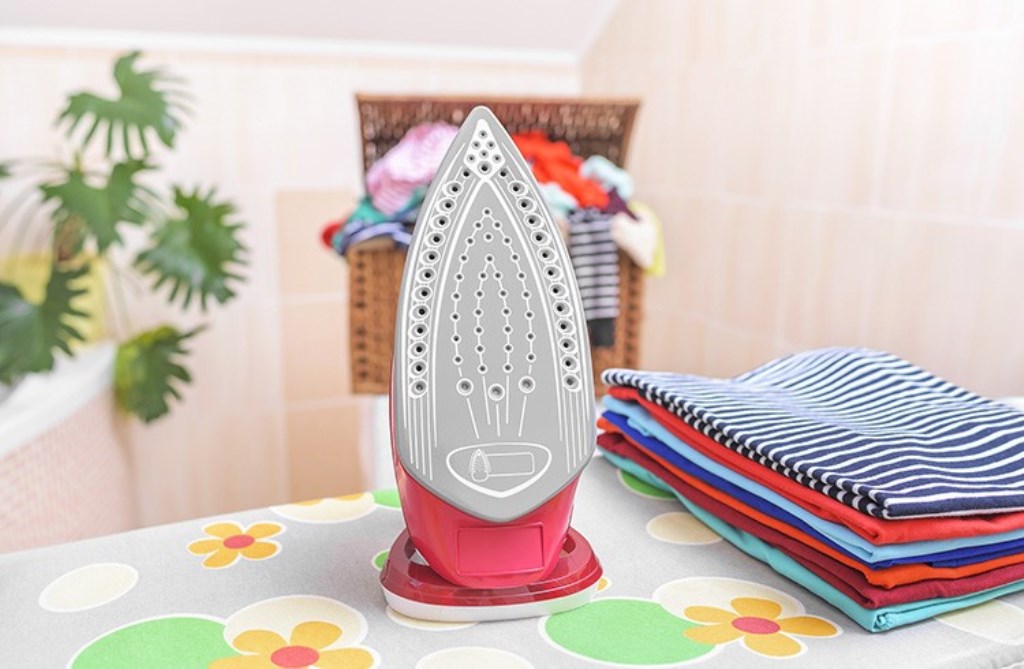
When choosing an iron, the material from which the sole part is made and its shape play a key role. If you make a mistake with the purchase, the device will become unusable after a few ironings and ruin things.
Video: how to choose the right sole for the iron





